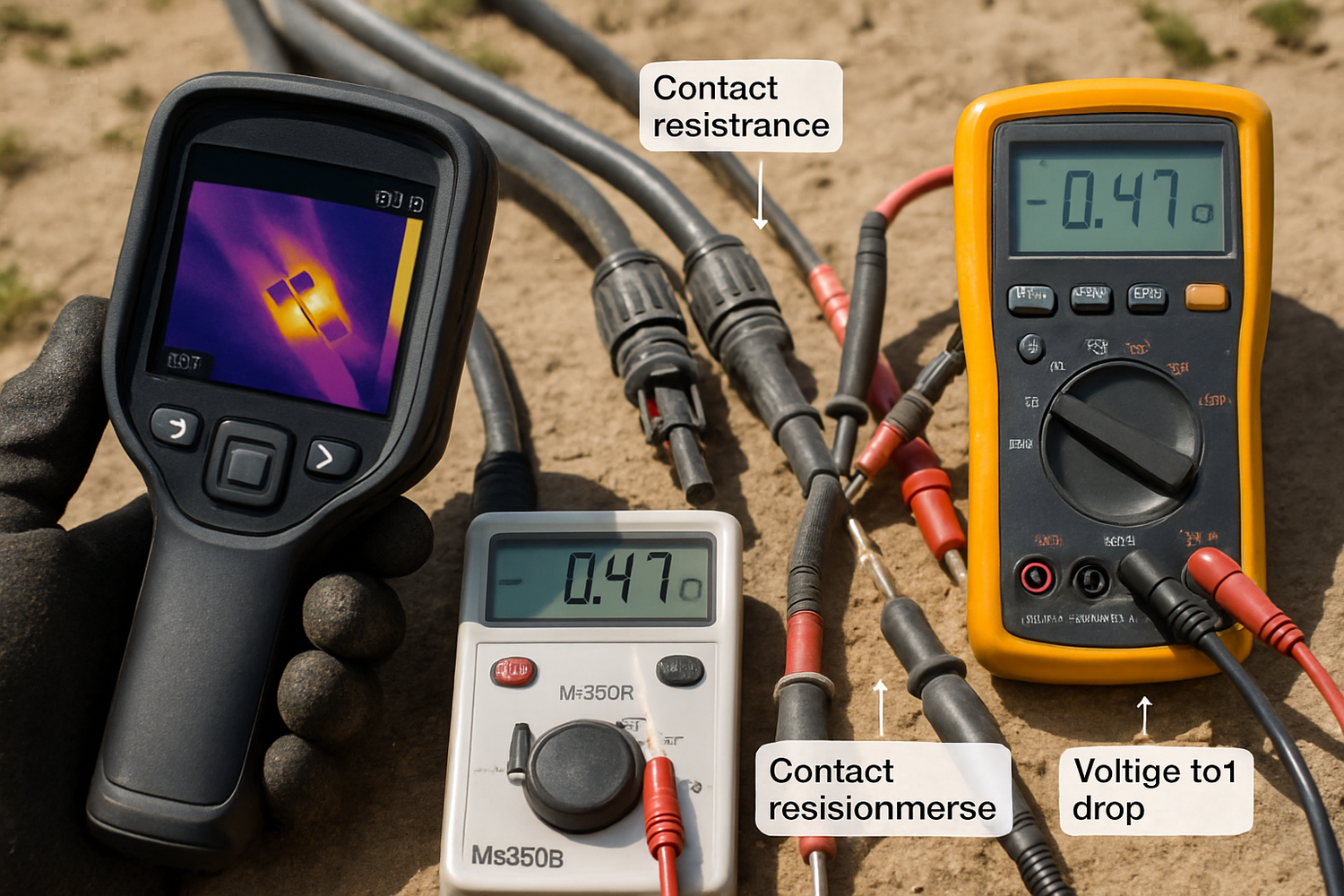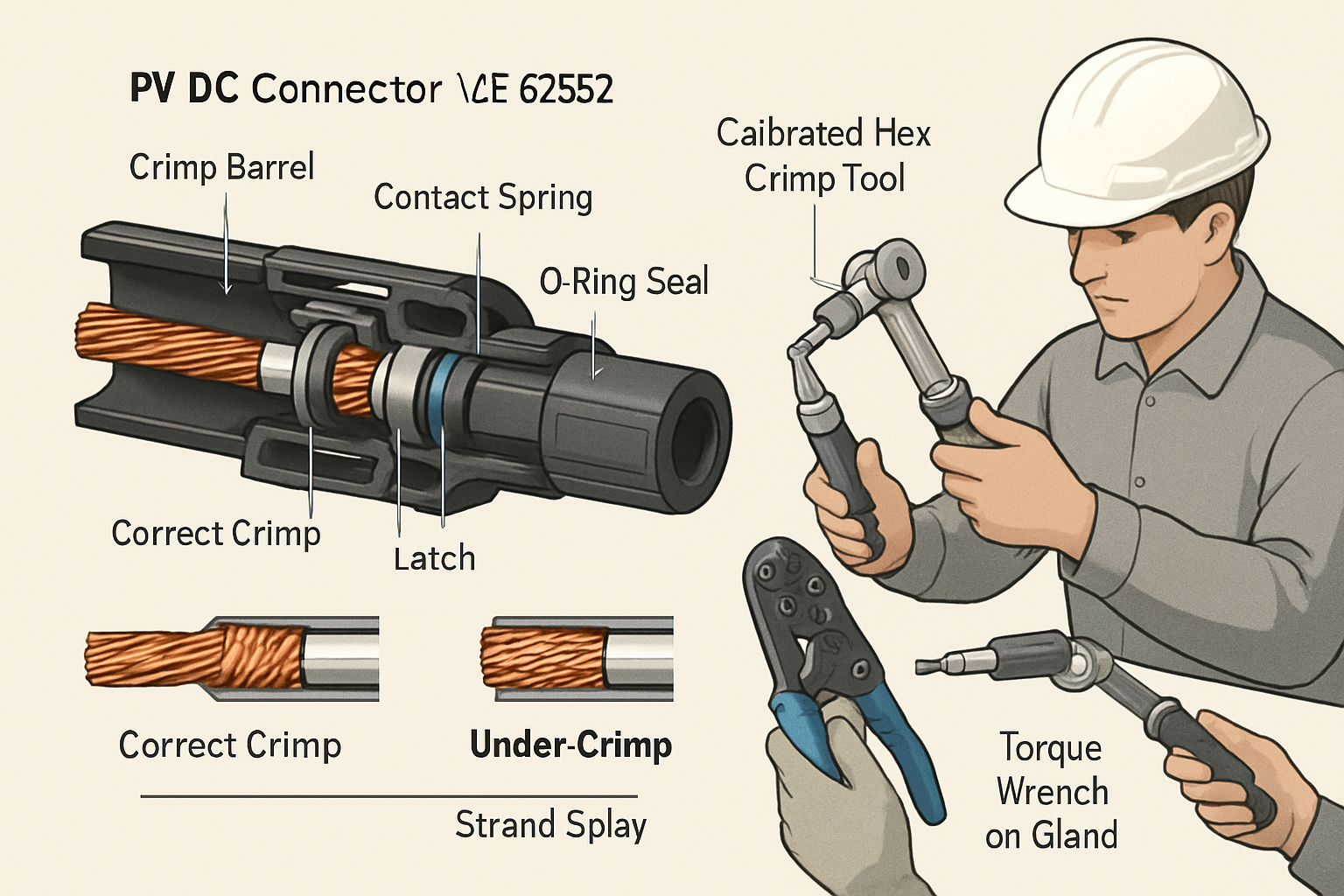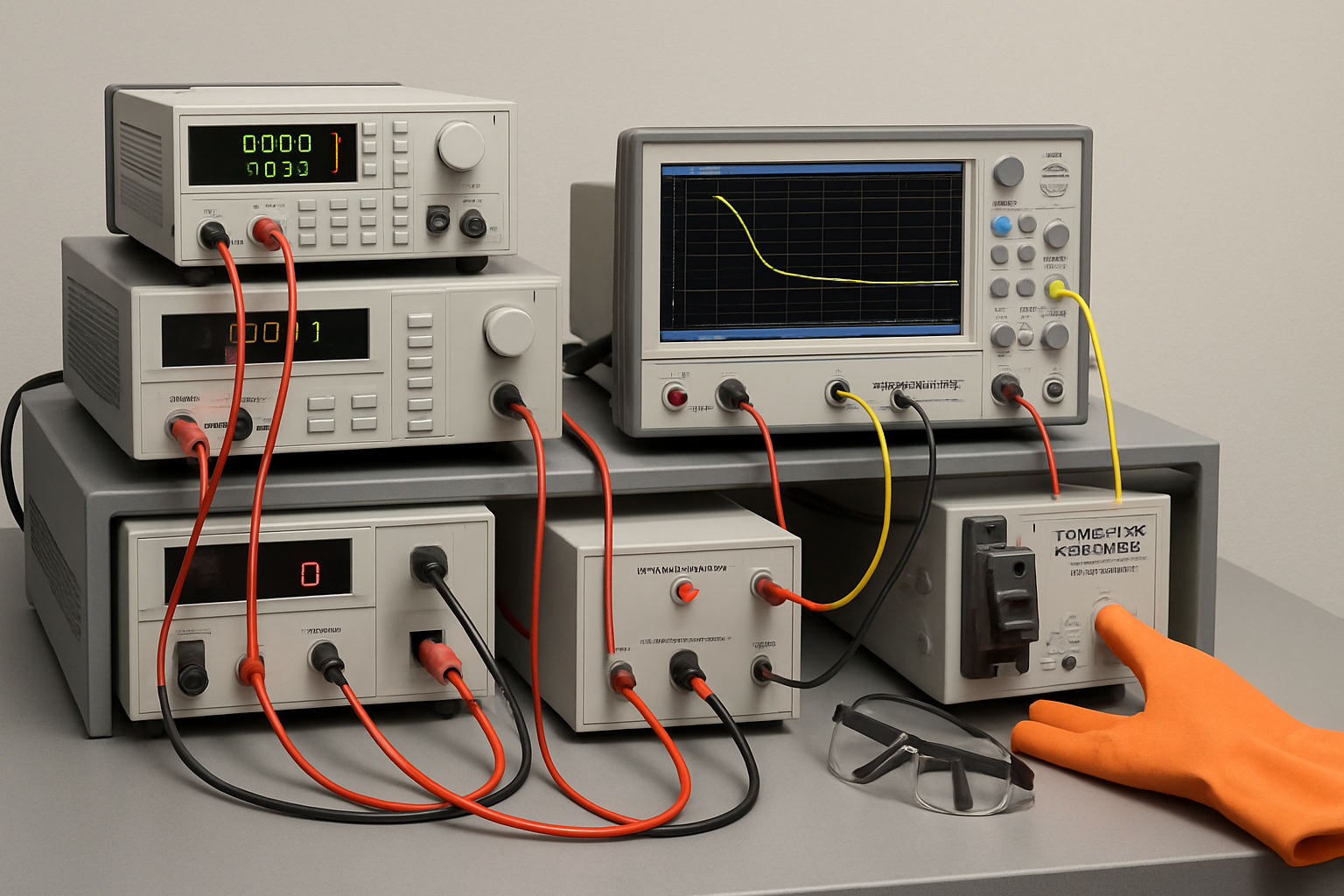Portable duty punishes connectors. Frequent mating, grit, UV, and vibration push contact resistance up and heat follows. This guide gives a field-ready, evidence-based workflow so you can catch connector wear early, avoid arcing, and plan replacements with confidence.
Why portable rigs accelerate connector wear
Mechanical and environmental stress
Daily setups increase mating cycles; dust and salt mist creep past aging seals; UV hardens plastics and O-rings. These stressors promote fretting corrosion and micro-pitting, raising milliohms. Safety and performance depend on low, stable contact resistance. For connector design and safety requirements, see IEC 62852 (PV DC connectors).
Electrical loading and heat
Portable rigs often run near rated current at midday, then cool quickly after sunset. Repeated thermal cycling loosens interfaces and increases resistance. Field studies link connector issues to avoidable losses and O&M cost—see NREL’s analyses of connector failures and O&M impacts: NREL Technical Report and the broader PV reliability resources at NREL PV Reliability.
A practical diagnosis workflow
Safety: De-energize before disassembly. Cover live PV leads, use insulated tools and eye protection. Follow manufacturer instructions and local codes. This is not legal or engineering advice.
1) Prep and baseline
- Clean exteriors so cracks and burns are visible.
- Record ambient temperature, irradiance, and string current to normalize thermal readings.
- Note connector make/rating; keep prior data for trends.
2) Visual and tactile screening
- Look for discoloration near the crimp, melted plastic, cracked latch tabs, green/black deposits, deformed O-rings.
- Check mating fit; wobble hints at worn housings or bent contacts.
- Flex relief boots and glands; stiffness or cracks reduce sealing and strain relief.
3) Electrical tests
- 4-wire contact resistance: Use a milliohm meter with Kelvin clamps on the crimp barrel and contact tail. Test both halves.
- Voltage drop under load: With current flowing, measure across the mated pair; rising drop = rising resistance.
- Insulation check (de-energized): Measure insulation resistance between conductor and outer surface to flag moisture ingress or cracks.
4) Thermal check under real load
- Run a steady current for 10–15 minutes and scan with an IR camera.
- Compare the hottest connector to ambient (ΔT) and across similar connectors on the string to spot outliers.
5) Mechanical checks
- Insertion/retention forces: Use a small spring scale (de-energized). Drops vs new parts indicate contact spring fatigue or latch wear.
- Crimp quality: Verify die imprint geometry and even deformation; perform a gentle tug test.
6) Seal integrity
- Inspect O-rings for flattening, cuts, or brittleness.
- With connectors unmated and capped, lightly water-spray; check for moisture after 10 minutes. Do not spray energized connectors.
Structured screening → measurement → action mirrors utility practice. For PV basics that inform diagnostics (temperature, irradiance, soiling), see U.S. DOE Solar Energy.
Indicative targets and actions
Always defer to your connector series datasheet. The ranges below reflect typical portable PV plugs up to ~15–20 A.
| Test | Tool | Portable-duty target | Action if exceeded |
|---|---|---|---|
| Contact resistance (per half) | 4-wire milliohm meter | ~0.2–0.8 mΩ as new; investigate >1.5 mΩ | ≥2.5–3 mΩ or fast upward trend → replace both halves |
| Voltage drop (mated pair) | DMM under load | ≤0.10–0.20 V at 10 A | ≥0.30 V → re-crimp/replace; inspect for heat damage |
| Thermal rise (ΔT above ambient) | IR camera | ≤25–30 °C at rated current | ≥35 °C → derate and schedule replacement; ≥40 °C → stop and replace now |
| Insulation resistance | IR tester, 250–500 V | ≥100 MΩ dry | <10 MΩ → dry/reseal or replace housings and O-rings |
| Insertion force | Spring scale | Per manufacturer spec; stable over time | Drop >25% vs new → inspect contact springs; replace if OOS |
| Retention force | Spring scale | Per manufacturer spec; latch intact | Drop >25% → replace housings; check for cracked latch |
Wear signatures, likely causes, and fixes
| Observed sign | Likely root cause | Fix |
|---|---|---|
| Brown/dark plastic near crimp | High-resistance crimp; overload cycling | Cut to bright copper; correct die; replace pair |
| Green/black contact deposits | Moisture + contamination; plating wear | Replace contacts/O-rings; add boots; improve storage |
| Loose latch/easy pullout | Latch fatigue or cracked housing | Replace housings; verify retention force |
| High ΔT on one side only | Local damage or poor crimp | Re-terminate that side; confirm resistance |
| White powder near metal | Plating erosion; salt exposure | Replace contacts; consider sealed caps in coastal sites |
Prefer crimp terminations for portable rigs. A proper crimp delivers lower resistance and resists vibration better than soldered joints. Verify with a milliohm check and tug test. For connector families and safety testing scope, refer to IEC 62852.
Preventive plan tailored for portable kits
Intervals that fit field use
- Every setup: quick visual, latch feel, and strain check.
- Monthly (frequent use): IR scan at midday, voltage-drop check, seal lookover.
- Quarterly: 4-wire resistance log and insertion/retention sampling.
- Annually: Replace O-rings/dust caps; retire pairs showing upward trends.
Field kit checklist
- IR camera or compact thermal imager
- True-RMS DMM and 4-wire milliohm meter
- Spring scale (0–200 N), spare O-rings/boots, matched connector pairs
- Crimp tool with correct die, cleaning wipes, and caps
Design tips that reduce wear
- Strain relief: keep connectors off the ground; avoid weight hanging from the plug.
- Short pigtails: reduce leverage/vibration at the joint.
- Caps and dry bags: store cables capped and dry; add desiccant in humid areas.
- Thermal margin: oversize connectors for current peaks to reduce ΔT.
Mini field case
A 400 W portable rig with a 12 A midday current showed erratic charging. Visuals were clean, but IR measured a 34 °C rise at one connector. Voltage drop at 12 A was 0.28 V. Milliohm readings: 0.7 mΩ (cool side) vs 2.6 mΩ (hot side). The crimp imprint was shallow. After re-termination with the correct die and replacing both halves: ΔT 16 °C at 12 A, Vdrop 0.11 V, contact resistance 0.6–0.8 mΩ. Current stabilized and daily Wh increased.
Key takeaways for safer uptime
- Use a repeatable process: visual → electrical → thermal → mechanical → seals.
- Log numbers; trends beat guesswork.
- Replace pairs, not singles; heat damage is rarely one-sided.
- Protect from grit, water, and strain; small steps extend service life.
Further reading
- IEC 62852 — Connectors for DC PV systems
- NREL — PV Reliability Research (connector issues and O&M)
- NREL Report — Connector failures and O&M implications
- U.S. DOE — Solar Energy Basics
Disclaimer
This material provides general safety and maintenance information. Always follow the product manual, applicable standards, and your Authority Having Jurisdiction (AHJ).





Leave a comment
All comments are moderated before being published.
This site is protected by hCaptcha and the hCaptcha Privacy Policy and Terms of Service apply.